 It’s a hot night in the city, and an equally hot lesbian is about to, as she puts it, “destroy my masculinity.” Just as her fancy dagger was about to be plunged hilt deep into the operational hub of my favourite sex organ, I woke up to find myself lounging awkwardly in a reasonably priced leather chair. After I regained consciousness, I couldn’t help but notice that I was wearing nothing but a pair of sweatshop-quality underpants (made in Turkmenistan, for her pleasure), my skin felt like it had been smeared with molasses, and the television was dripping blood from every orifice. Apparently, I was about to start watching something called The Blood Spattered Bride (a.k.a. La Novia Ensangrentada). And what, pre tell, might that be, you ask? Well, it’s a moderately lurid tale of female empowerment, unorthodox ring arrangement, pigeon cage sex and sand snorkeling by writer-director Vicente Aranda, based on Sheridan Le Fanu‘s novel “Carmilla.” As to how this particular slice of refined seediness ended up being put in front of face will probably remain a mystery–I don’t recall buying it, or even putting it in the machine that I play movies on. However, once I spotted the woman in the gossamer getup lurking outside the hotel where the film’s newlyweds were about to spend their first night together as a married couple, it failed to matter how this movie got put in front of me, all I knew is that I had to find out what kind of Euro-centric insanity this curious woman was going to unleash on this unsuspecting couple.
It’s a hot night in the city, and an equally hot lesbian is about to, as she puts it, “destroy my masculinity.” Just as her fancy dagger was about to be plunged hilt deep into the operational hub of my favourite sex organ, I woke up to find myself lounging awkwardly in a reasonably priced leather chair. After I regained consciousness, I couldn’t help but notice that I was wearing nothing but a pair of sweatshop-quality underpants (made in Turkmenistan, for her pleasure), my skin felt like it had been smeared with molasses, and the television was dripping blood from every orifice. Apparently, I was about to start watching something called The Blood Spattered Bride (a.k.a. La Novia Ensangrentada). And what, pre tell, might that be, you ask? Well, it’s a moderately lurid tale of female empowerment, unorthodox ring arrangement, pigeon cage sex and sand snorkeling by writer-director Vicente Aranda, based on Sheridan Le Fanu‘s novel “Carmilla.” As to how this particular slice of refined seediness ended up being put in front of face will probably remain a mystery–I don’t recall buying it, or even putting it in the machine that I play movies on. However, once I spotted the woman in the gossamer getup lurking outside the hotel where the film’s newlyweds were about to spend their first night together as a married couple, it failed to matter how this movie got put in front of me, all I knew is that I had to find out what kind of Euro-centric insanity this curious woman was going to unleash on this unsuspecting couple.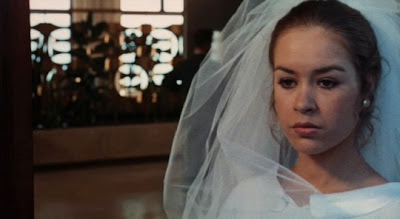 Just as blushing bride Susan (Maribel Martín)–the longness of her wedding veil in constant danger of being trampled or caught in a door–was about to enter the hotel, she notices a strange women watching her from a distance. She pauses to stare at her, and sports a look of unfulfilled longing as does so. On the other hand, her husband (Simón Andreu) doesn’t observe this woman at all. His thoughts are mainly centered around the whims and wants of his napping Iberian cock. Unfortunately for him, and his napping Iberian cock, Susan imagines herself being raped by a man (his face obscured by pantyhose) who was hiding in a closet, and demands that they leave at once.
Just as blushing bride Susan (Maribel Martín)–the longness of her wedding veil in constant danger of being trampled or caught in a door–was about to enter the hotel, she notices a strange women watching her from a distance. She pauses to stare at her, and sports a look of unfulfilled longing as does so. On the other hand, her husband (Simón Andreu) doesn’t observe this woman at all. His thoughts are mainly centered around the whims and wants of his napping Iberian cock. Unfortunately for him, and his napping Iberian cock, Susan imagines herself being raped by a man (his face obscured by pantyhose) who was hiding in a closet, and demands that they leave at once. Relocating to her husband’s palatial/ghoulish childhood home, Susan soon finds out that her husband and the imaginary rapist aren’t that different when it comes to their overall sexual disposition. A tad on the rough side (loose bits of white thread from her bridal panties become ensnared in her dense pubic hair as he forcefully unsheathes them from their hip-hugging prison), Susan’s husband seemed determined to fornicate with her in every room of the house. And while I’ve read that’s quite common for newlyweds to fuck, or, at the very least, give tepid handjobs, in various different places during the early going of a couple’s marriage, I’m just not sure many have attempted to get their stain on in a pigeon cage.
Relocating to her husband’s palatial/ghoulish childhood home, Susan soon finds out that her husband and the imaginary rapist aren’t that different when it comes to their overall sexual disposition. A tad on the rough side (loose bits of white thread from her bridal panties become ensnared in her dense pubic hair as he forcefully unsheathes them from their hip-hugging prison), Susan’s husband seemed determined to fornicate with her in every room of the house. And while I’ve read that’s quite common for newlyweds to fuck, or, at the very least, give tepid handjobs, in various different places during the early going of a couple’s marriage, I’m just not sure many have attempted to get their stain on in a pigeon cage.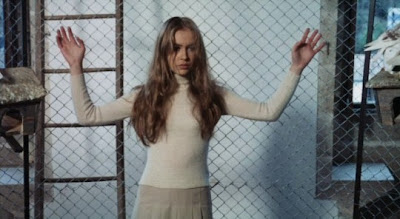 The pigeon cage sequence does an excellent job of showcasing the twisted nature of Susan and her husband’s relationship. Locking the flimsy cage door, all to aware that he won’t have too much trouble breaking it down, Susan makes the turtleneck-wearing degenerate work hard for his daily allotment of pristine girl pussy.
The pigeon cage sequence does an excellent job of showcasing the twisted nature of Susan and her husband’s relationship. Locking the flimsy cage door, all to aware that he won’t have too much trouble breaking it down, Susan makes the turtleneck-wearing degenerate work hard for his daily allotment of pristine girl pussy. Husband? Turtleneck-wearing degenerate? What exactly was the name of Susan’s husband? I mean, not once did I hear it uttered out loud during this film. I think I’m going start calling him Gerhard Landau. Why “Gerhard”? Well, I like the way it sounds when pronounced with a bad German accent. And “Landau” because Simón reminded me of a young Martin Landau (Juliet Landau’s father)–you know, when looked at from certain angles. But then I thought, maybe he has no name because he is supposed to represent men in general. I know it’s a bit of stretch, but that’s all I could come up with. Either way, the rough-sex-enjoying motherscratcher is Gerhard Landau as far as I’m concerned.
Husband? Turtleneck-wearing degenerate? What exactly was the name of Susan’s husband? I mean, not once did I hear it uttered out loud during this film. I think I’m going start calling him Gerhard Landau. Why “Gerhard”? Well, I like the way it sounds when pronounced with a bad German accent. And “Landau” because Simón reminded me of a young Martin Landau (Juliet Landau’s father)–you know, when looked at from certain angles. But then I thought, maybe he has no name because he is supposed to represent men in general. I know it’s a bit of stretch, but that’s all I could come up with. Either way, the rough-sex-enjoying motherscratcher is Gerhard Landau as far as I’m concerned. Noticing that there are no portraits of female family members on the walls of her husband’s house, Susan does a little digging. After grilling Carol (Maria-Rosa Rodriguez), the shy twelve-year old daughter of two the home’s servants, she discovers that the women are all located in the cellar. Initially it’s difficult to say why they’re all down there, but it’s safe to say the reason has got to be nonsensical in nature.
Noticing that there are no portraits of female family members on the walls of her husband’s house, Susan does a little digging. After grilling Carol (Maria-Rosa Rodriguez), the shy twelve-year old daughter of two the home’s servants, she discovers that the women are all located in the cellar. Initially it’s difficult to say why they’re all down there, but it’s safe to say the reason has got to be nonsensical in nature.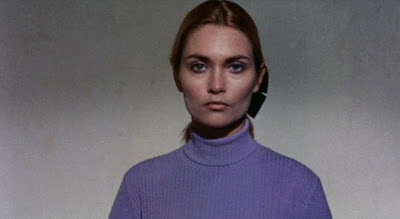 Occasionally, while frolicking around the grounds of the expansive estate, Susan would catch glimpses of a mysterious woman (Alexandra Bastedo) in flowing nightclothes. These occasional sightings soon turn into regular occurrences. It’s gets to the point where the woman, who may or may not be Mircalla Karstein, a crazed family member who stabbed her husband on their wedding night two hundred years ago, is encouraging Susan to stab Gerhard in her dreams.
Occasionally, while frolicking around the grounds of the expansive estate, Susan would catch glimpses of a mysterious woman (Alexandra Bastedo) in flowing nightclothes. These occasional sightings soon turn into regular occurrences. It’s gets to the point where the woman, who may or may not be Mircalla Karstein, a crazed family member who stabbed her husband on their wedding night two hundred years ago, is encouraging Susan to stab Gerhard in her dreams. Reality and the dream world collide as the dagger Susan and Mircalla use to ventilate Gerhard in her dream shows up in their bed. At this point, The Blood Spattered Bride goes into what I like to call its “knife hiding phase.” Now, should every movie have a “knife hiding phase”? Of course not. Don’t be ridiculous. Nevertheless, it makes perfect sense to have one in this film since there’s a knife and a person who doesn’t want to be brutally murdered by said knife. Unfortunately for the latter, the knife has a habit showing up unexpectedly. You see, every time Gerhard would hide it, the sinister-looking blade would somehow reappear and end up once again in Susan’s possession.
Reality and the dream world collide as the dagger Susan and Mircalla use to ventilate Gerhard in her dream shows up in their bed. At this point, The Blood Spattered Bride goes into what I like to call its “knife hiding phase.” Now, should every movie have a “knife hiding phase”? Of course not. Don’t be ridiculous. Nevertheless, it makes perfect sense to have one in this film since there’s a knife and a person who doesn’t want to be brutally murdered by said knife. Unfortunately for the latter, the knife has a habit showing up unexpectedly. You see, every time Gerhard would hide it, the sinister-looking blade would somehow reappear and end up once again in Susan’s possession. Tired of seeing the dagger re-emerge the way that it does, Gerhard buries it at the beach. While that sounds like a surefire way to permanently loose something, the film’s script throws a naked women buried in the sand ten feet away from the very place he chose to bury the knife. Breathing via snorkel, Gerhard doesn’t seem shocked by this discovery and takes the still naked women home with him. It turns out that snorkel lady’s name is Carmilla and she is happy to stay the night with Susan and Gerhard. Of course, Susan, being quite the talented sketch artist, soon discovers that Mircalla Karstein and this Carmilla person bare a striking resemblance to one another.
Tired of seeing the dagger re-emerge the way that it does, Gerhard buries it at the beach. While that sounds like a surefire way to permanently loose something, the film’s script throws a naked women buried in the sand ten feet away from the very place he chose to bury the knife. Breathing via snorkel, Gerhard doesn’t seem shocked by this discovery and takes the still naked women home with him. It turns out that snorkel lady’s name is Carmilla and she is happy to stay the night with Susan and Gerhard. Of course, Susan, being quite the talented sketch artist, soon discovers that Mircalla Karstein and this Carmilla person bare a striking resemblance to one another.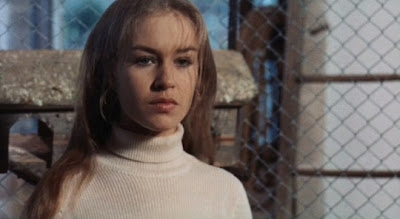 Up until this point, the film has had a languid, almost dreamlike quality. This stuporous aura all changes the moment Gerhard starts to seek the advice a doctor (Dean Selmier). Suddenly, words like, “vampirism” and “lesbianism” are being bandied about, Susan and Mircalla/Carmilla are seen wandering the grounds in transparent clothing, and the notorious dagger is back (no beach can tame its desire to stab men over and over again in a bedroom setting). In other words, the crazy is substantially turned up. And I couldn’t have been more pleased.
Up until this point, the film has had a languid, almost dreamlike quality. This stuporous aura all changes the moment Gerhard starts to seek the advice a doctor (Dean Selmier). Suddenly, words like, “vampirism” and “lesbianism” are being bandied about, Susan and Mircalla/Carmilla are seen wandering the grounds in transparent clothing, and the notorious dagger is back (no beach can tame its desire to stab men over and over again in a bedroom setting). In other words, the crazy is substantially turned up. And I couldn’t have been more pleased. An exquisite example of stillness under extreme duress (her bridal bodice is forcibly torn twice in one evening), Maribel Martín gives a wonderfully dignified performance as Susan, the newly married gal who longs to stab her husband in the genitals while he sleeps.
An exquisite example of stillness under extreme duress (her bridal bodice is forcibly torn twice in one evening), Maribel Martín gives a wonderfully dignified performance as Susan, the newly married gal who longs to stab her husband in the genitals while he sleeps.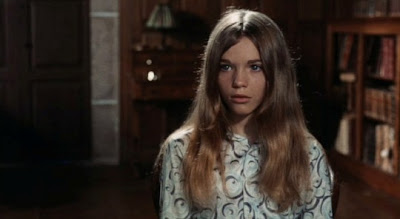 In terms of creepy tweens who don’t talk a lot, I thought Maria-Rosa Rodriguez was super cute in an off-kilter, I wonder if she’s thinking about slitting my throat, kinda way. To say that I was mildly alarmed by the fabric-challenged temperament of her black skirt and the uncompromising tightness of her red knee-socks would definitely be an understatement.
In terms of creepy tweens who don’t talk a lot, I thought Maria-Rosa Rodriguez was super cute in an off-kilter, I wonder if she’s thinking about slitting my throat, kinda way. To say that I was mildly alarmed by the fabric-challenged temperament of her black skirt and the uncompromising tightness of her red knee-socks would definitely be an understatement.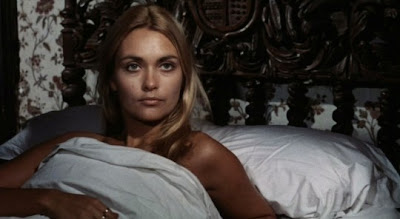 If my significant other is going to be persuaded to kill me with a large dagger, I want them to be persuaded by someone who looks like Alexandra Bestado.
If my significant other is going to be persuaded to kill me with a large dagger, I want them to be persuaded by someone who looks like Alexandra Bestado. The perfect film for backward-thinking goths who are interested in lesbian relationships that involve vampires and shooting fox hunters in the crotch with shotguns, The Blood Spattered Bride, with its eerie organ score by Antonio Pérez Olea, manages to create an ethereal atmosphere with an effortless elan.
The perfect film for backward-thinking goths who are interested in lesbian relationships that involve vampires and shooting fox hunters in the crotch with shotguns, The Blood Spattered Bride, with its eerie organ score by Antonio Pérez Olea, manages to create an ethereal atmosphere with an effortless elan.video uploaded by sideshowcarny
This is yet another film I became aware of thanks to the highly influential “Eurotrash or American Apparel,” a blog entry I came across at Love Train for the Tenebrous Empire.
…
